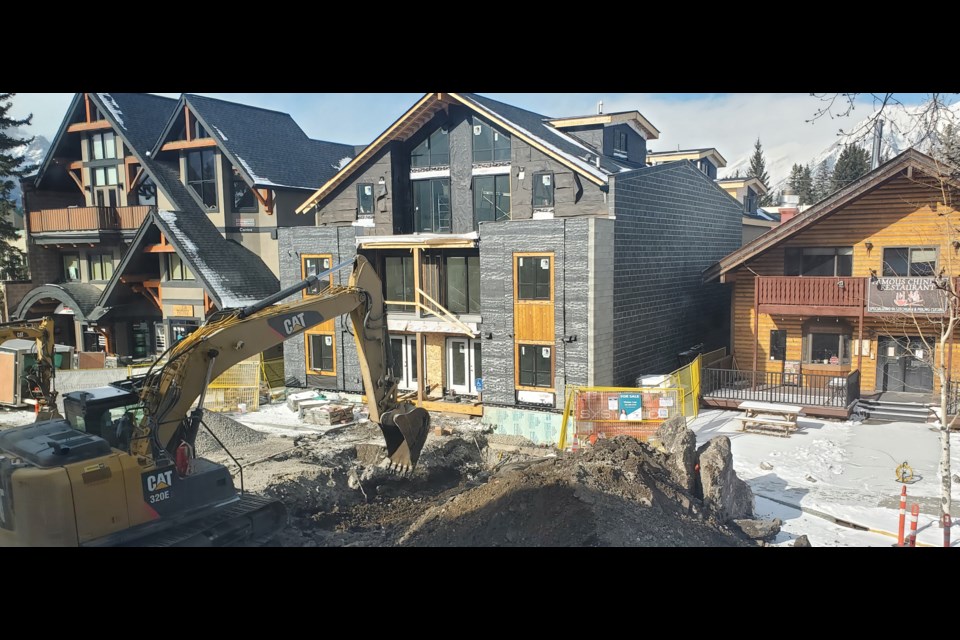CANMORE – A push by developers to have the Town of Canmore make public its calculations model for off-site levies will have a provincial tribunal decide what is heard at an upcoming hearing.
Five developers and Bow Valley Builders and Developers Association (BOWDA) are asking the Town to publicly produce the levy calculations.
Kathleen Elhatten-Lake, a partner with Shores Jardine and one of the legal representatives for developers, said the intent is to attain information they have sought for several months and is legislatively required to be produced.
“The appellants have said the Town has an obligation to provide calculations and make those publicly available when passing an off-site levy bylaw [according to the MGA],” she said. “We have always asked for the calculations. It is only on July 12 that the Town responded and said ‘we can’t give you calculations, that’s the CORVUS model’ so all the appellants want is the calculations. The Town is the one who said the only calculations are the CORVUS model.”
CORVUS is widely used by Alberta municipalities to calculate off-site levy costs.
Janice Agrios, a lawyer from Kennedy Agrios representing CORVUS, said the CORVUS model was offered to developers’ but some information may be confidential due to business proprietary reasons.
“[We will] try and figure out a way to get the appellants the information they say they need,” she said.
Elhatten-Lake pushed to have the calculations released, but if they weren’t for procedural fairness reasons the Town shouldn’t be able to rely on them for evidence at the scheduled hearing in October.
“If the Town can’t provide the calculations or the CORVUS model and didn’t make it public, it can’t then rely on pieces and call evidence about it later,” she said and that it’s “information that should have been part of the Town’s off-site levy bylaw” and they’ve “repeatedly asked for these.”
In the 2022 off-site levy report by the Town, it noted “CORVUS results have been rigorously validated by the Town of Canmore.”
A March 22 email from Gwendolyn Stewart-Palmer, a legal representative for developers, to Town solicitor Adam Driedzic outlined they “are not asking for the model, but the report prepared by CORVUS.”
An additional March 25 email from Chris Ollenberger, chair of BOWDA’s off-site levy committee, to Town staffers Sally Caudill, Whitney Smithers, Andreas Comeau and Driedzic asked for a “memorandum or email that outlines all of the inputs and assumptions and subsequent outputs from the CORVUS model that the Town used to extract from to incorporate into their bylaw”.
A March 27 email had Smithers respond that the Town’s reports “look similar to the CORVUS reports by coincidence more than anything. We created our own tables, which are populated from the CORVUS model. We are using the model to determine rates and we are reporting the same information in our own tables.”
Canmore council passed its off-site levy bylaw amendment earlier this year and also approved $500,000 in estimated legal costs and expert fees. Town staff and the development community significantly differed on the costs associated with the levy.
Town staff told council without an update to the bylaw, it could cost the municipality between $1-2 million a year due to necessary off-site collections.
An appeal against Canmore’s off-site levy bylaw amendment was made May 24 by Spring Creek Mountain Village, Three Sisters Mountain Village Properties Limited (TSMVPL), Stone Creek Resorts, Altitude Developments Limited (Logel Homes), BOWDA and SC3 Limited Partnership (Devonian Properties).
Elhatten-Lake gave the example of the Altitude Developments project in The Gateway at Three Sisters Mountain Village, which is facing significant cost increases as a result of the levy.
The 239-unit residential project was approved by Canmore’s planning commission in June, meaning it is subject to the new off-site levy bylaw amendment. The change in off-site levies meant an increase of 500 per cent, with a per unit cost jumping $16,000.
“There are significant impacts on developers on their ability to move forward with development,” she said, adding it creates uncertainty which is a “death knell for development.”
Elhatten-Lake said she had “substantive concerns” because the Municipal Government Act requires calculations to be publicly available before an off-site levy bylaw is passed.
“We just want transparency, which is a fundamental part of the off-site levy,” she said. “We just want to understand how you get from 10s of millions of dollars to an amount per unit, which is a pretty basic question.
“We just want an answer from the Town. We just want them to set the guidelines of what calculations they did, so we can give them to our expert and have them comment. The Town seems unable to answer what its calculations are, which given the content of the MGA that requires you to make it publicly available as information I think is significantly concerning. This is why a confidential meeting is inappropriate.”
Gavin Fitch, a lawyer with McLennan Ross representing the Town, said in the immediate days before the preliminary hearing, an offline meeting was offered to be held between the Town, CORVUS and developers on how information was provided but it was rejected.
“The Town is not averse to producing the calculations,” he said. “The issue we have struggled with is we understood the calculations may be confidential. If they’re not and if there’s a way to produce them or we’re ordered to produce them, we will confer further with CORVUS about how we can do that and we’ll produce them.”
The three-person LPRT panel will provide a decision at a later date. The appeal hearing is scheduled for October.




